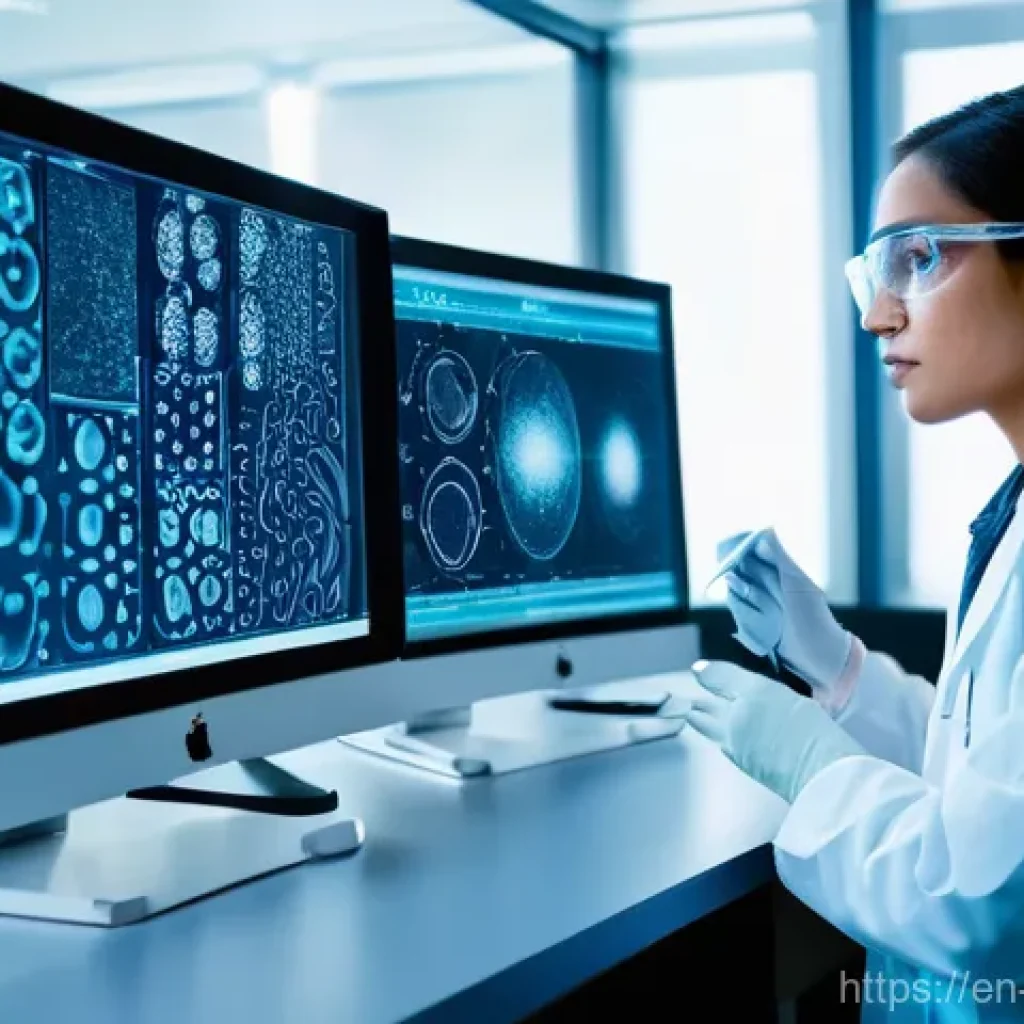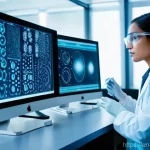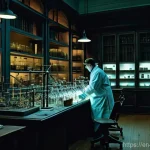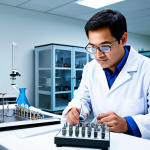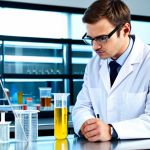Ever wonder what’s really happening with the air we breathe, the water we drink, or even the soil our food grows in? It’s easy to feel overwhelmed by headlines about pollution and climate change, but what if I told you there’s a fascinating, powerful science working tirelessly behind the scenes to understand and fix these challenges?
I’m talking about environmental chemistry, and it’s so much more than just complex formulas; it’s about the very essence of our planet’s health and our own wellbeing.
Lately, I’ve been diving deep into some truly eye-opening trends, like the persistent problem of “forever chemicals” (you know, PFAS) showing up everywhere, and the alarming spread of microplastics in even the most remote corners of our world.
It really makes you pause and think about the invisible threats lurking in our daily lives. But here’s the exciting part: environmental chemists are on the front lines, innovating incredible solutions!
We’re seeing a huge push towards “green chemistry” – designing products and processes that are inherently safer and more sustainable from the get-go. Think about the move towards a circular economy where waste isn’t just discarded but reborn into new resources.
These aren’t just academic concepts; these are tangible shifts happening right now that will directly impact our future. It’s about leveraging cutting-edge science to protect our natural world and ensure a healthier tomorrow for everyone.
This field is constantly evolving, presenting both daunting challenges and inspiring breakthroughs that directly touch our lives, from the purity of our tap water to the viability of future technologies.
It’s a journey of discovery that’s both crucial and endlessly intriguing. Let’s explore this vital field and uncover how chemistry is shaping a cleaner, brighter future for all of us.
Unmasking the Invisible Threats: Forever Chemicals & Microplastics
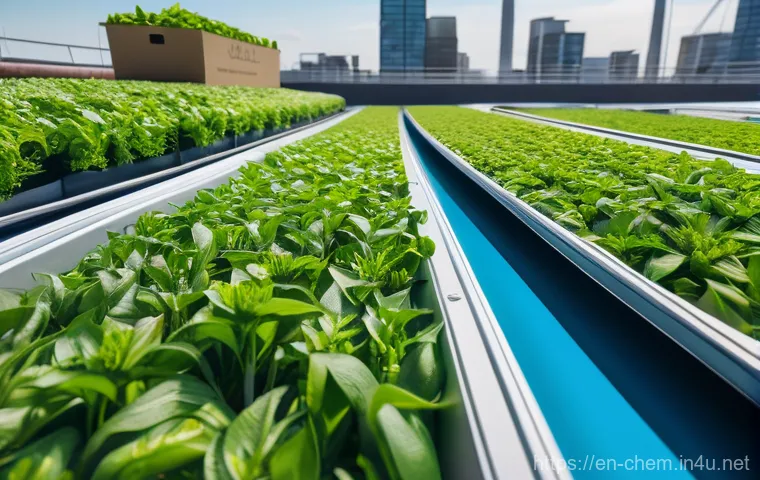
The Pernicious Problem of PFAS
You know, lately, I’ve been really deep-diving into what’s often called “forever chemicals,” and honestly, it’s a bit unsettling how widespread PFAS (per- and polyfluoroalkyl substances) truly are. It feels like every week there’s a new report detailing how these persistent compounds are showing up in our water, our soil, and even our bodies. I remember first hearing about them a few years back, thinking it was a niche industrial issue, but my research has shown me just how much they’ve permeated our daily lives. From non-stick pans and waterproof gear to food packaging and fire-fighting foams, these chemicals were once celebrated for their resistance to heat, water, and oil. The downside? They literally don’t break down in the environment or in our bodies, earning them that chilling “forever” moniker. This persistence means they accumulate, and while the science is still evolving, there are growing concerns about their links to various health issues, including certain cancers, thyroid disease, and developmental problems. It’s a sobering thought that something designed for convenience could have such long-lasting, invisible consequences for us and for generations to come. This challenge really highlights the crucial role environmental chemistry plays in identifying these threats and pushing for safer alternatives, but it’s a huge mountain to climb.
Microplastics: A Tiny Threat with Huge Implications
Speaking of invisible threats, let’s talk about microplastics. If you’ve been following my posts, you know I’ve been utterly fascinated, and a little horrified, by how these tiny fragments of plastic have infiltrated virtually every corner of our planet. I mean, we’re talking about pieces smaller than 5 millimeters, yet their impact is anything but small. I recently read about studies finding them in the deepest ocean trenches and even in Arctic ice, which just blows my mind. It really makes you pause and think about where all that plastic we use ends up. Our clothes, car tires, packaging, and even those exfoliating face washes we used to love – they all contribute to this ever-growing soup of plastic particles. Once released, they’re ingested by marine life, making their way up the food chain, and yes, into us. The full health implications for humans are still being investigated, but you can’t help but feel a knot in your stomach thinking about microscopic plastic floating around inside you. What I’ve learned is that environmental chemists are on the front lines, not just detecting these particles in new environments, but also researching innovative ways to filter them out of our water and even design biodegradable alternatives. It’s a complex puzzle, but seeing the dedication to finding solutions gives me a glimmer of hope.
The Green Revolution: Chemistry’s Sustainable Makeover
Designing for a Better Tomorrow: Principles of Green Chemistry
It’s easy to get bogged down by the problems, but let me tell you, there’s an incredible movement happening in the chemical world: green chemistry. When I first heard the term, I thought it was just about recycling more, but it’s so much more profound than that. It’s a complete paradigm shift, fundamentally rethinking how we design chemical products and processes from the ground up, aiming for inherently safer and more sustainable outcomes. Imagine chemists creating new materials and reactions that *don’t* produce hazardous waste, or using renewable feedstocks instead of dwindling fossil fuels. It’s about preventing pollution at its source, rather than just cleaning it up afterwards. My favorite part about this is the ingenuity involved. Companies are developing biodegradable plastics that genuinely break down, inventing new catalysts that make reactions more efficient and less energy-intensive, and finding ways to replace toxic solvents with safer ones like water or supercritical CO2. It’s not just about compliance; it’s about competitive advantage and creating a better future. When I see companies genuinely embracing these principles, it fills me with a sense of optimism about what’s possible when innovation meets environmental responsibility. It’s proof that chemistry doesn’t have to be part of the problem; it can be a powerful part of the solution.
Beyond Recycling: Embracing the Circular Economy
While recycling is good, green chemistry takes us a step further into the realm of the circular economy. This concept, to me, is revolutionary because it moves beyond the traditional “take-make-dispose” linear model that has caused so many of our current environmental woes. Instead, it’s about keeping resources in use for as long as possible, extracting the maximum value from them while in use, then recovering and regenerating products and materials at the end of each service life. It feels like a beautiful dance where waste isn’t just discarded but reborn into new resources. Think about it: instead of a single-use plastic bottle ending up in a landfill or the ocean, it’s chemically broken down into its original monomers, which can then be used to create a brand-new, high-quality bottle. This isn’t just wishful thinking; it’s becoming a reality thanks to cutting-edge environmental chemistry. We’re seeing incredible advancements in chemical recycling and upcycling, where chemists are developing processes to transform complex waste streams into valuable feedstocks for new products. This approach minimizes waste, reduces demand for virgin resources, and lowers environmental impact. It’s an exciting vision of a future where sustainability is built into the very fabric of our economy, and honestly, it’s the kind of big-picture thinking that truly gets me excited about the power of science.
Water, Water Everywhere: Keeping Our H2O Pristine
Innovations in Water Treatment Technologies
Clean water is something many of us take for granted, but the truth is, ensuring its purity is a relentless battle fought by environmental chemists every single day. I’ve been fascinated by how far water treatment has come, especially with the emerging contaminants we’re facing. Gone are the days when simple filtration and chlorination were enough. Now, we’re talking about sophisticated processes that can tackle everything from pharmaceuticals and pesticides to those notorious PFAS compounds. I’ve been reading up on advanced oxidation processes (AOPs) that use powerful oxidants like ozone or UV light in combination with hydrogen peroxide to break down stubborn pollutants into harmless substances. Then there are membrane filtration technologies, like reverse osmosis and nanofiltration, which act like super-fine sieves, physically removing even microscopic particles and dissolved contaminants. It’s truly incredible how these innovations are safeguarding our tap water, making it safer to drink and preserving aquatic ecosystems. The dedication of chemists to constantly refine these methods and develop new ones, especially for areas facing severe water scarcity or contamination, is something I deeply admire. It underscores how vital this field is to global public health and environmental integrity, giving me a lot of confidence in our ability to manage this precious resource.
Monitoring Aquatic Ecosystems for Health
It’s not enough to just treat our drinking water; keeping our lakes, rivers, and oceans healthy is equally critical, and this is where environmental chemistry acts as the vigilant watchdog of aquatic ecosystems. I recently learned about a project where scientists are using highly sensitive analytical techniques to monitor water bodies for emerging contaminants, which is basically a fancy term for pollutants that we’re only just starting to understand or detect. This isn’t just about looking for the obvious industrial spills; it’s about detecting trace amounts of everyday chemicals that accumulate over time. Think about the residues from personal care products, detergents, and even veterinary medicines that can find their way into our waterways. Environmental chemists develop and deploy sophisticated sensors and sampling methods that can provide real-time data on water quality, pH levels, dissolved oxygen, and the presence of specific pollutants. This constant vigilance allows us to understand the impacts of human activity, identify potential threats before they become full-blown crises, and guide conservation efforts. Personally, seeing data that shows a river recovering after years of pollution, thanks to targeted chemical interventions and monitoring, is one of the most rewarding aspects of understanding this field. It’s like getting a health report for our planet’s aquatic life, and having the tools to help it heal is truly empowering.
Breathing Easy: Tackling Air Pollution with Smart Chemistry
Understanding and Combatting Urban Smog
You know that hazy, yellowish-brown air that sometimes hangs over big cities? That’s urban smog, and it’s a complex chemical cocktail that environmental chemists are tirelessly working to understand and dismantle. I used to think smog was just “dirty air,” but it’s actually formed when sunlight reacts with pollutants emitted from cars, factories, and other sources, creating ground-level ozone and fine particulate matter. It’s a real health hazard, causing respiratory problems and making it hard for people to breathe. But here’s where chemistry steps in with some brilliant solutions! I’ve been really impressed by the advancements in catalytic converters for vehicles, which transform harmful gases like nitrogen oxides and carbon monoxide into less toxic substances before they leave the tailpipe. Industrial plants are also implementing chemical scrubbers and filters to strip out pollutants from their emissions. The ongoing challenge is that urban environments are always changing, with new sources and conditions, so environmental chemists are constantly developing better models to predict air quality and innovating new catalysts and filtration materials. It’s a constant chess match against invisible adversaries, but seeing the improvements in air quality in many major cities over the past few decades, largely thanks to these chemical interventions and policy changes, genuinely makes me feel like we’re moving in the right direction.
Indoor Air Quality: Beyond the Outdoors

While we often worry about outdoor air pollution, I’ve found that what’s happening inside our homes and offices can be just as, if not more, impactful on our health. It’s something I’ve personally focused on more recently. Think about it: we spend upwards of 90% of our time indoors! And many common household products, building materials, and even our cooking can release volatile organic compounds (VOCs), formaldehyde, and other pollutants. New furniture, paints, cleaning supplies – they all off-gas chemicals. Even something as simple as burning candles or using a gas stove can impact your indoor air quality significantly. This is where environmental chemistry offers practical solutions. Chemists are developing advanced air purifiers with specialized filters and sorbents designed to capture specific indoor pollutants, not just dust. We’re also seeing an amazing push for “green building” materials and paints that emit fewer VOCs, making our indoor spaces much healthier. My personal tip, based on diving into this research, is regular ventilation and choosing low-VOC products. It’s empowering to know that with a little chemical insight, we can take proactive steps to ensure the air we breathe in our most personal spaces is as clean and healthy as possible. It truly shows how environmental chemistry touches every aspect of our daily lives, even the unseen ones.
From Waste to Wonder: The Circular Economy in Action
Transforming Trash into Treasure: Chemical Recycling
Alright, let’s talk about something truly groundbreaking: chemical recycling. For years, we’ve relied on mechanical recycling, which is great, but it often downcycles plastics, meaning the quality degrades with each cycle. But imagine if we could take a jumbled mess of mixed plastics, break them down to their basic chemical building blocks – their monomers – and then use those to create brand-new, virgin-quality plastics. That’s the magic of chemical recycling, and it’s truly a game-changer for the circular economy. Environmental chemists are at the forefront of this, developing incredible processes like pyrolysis, gasification, and depolymerization. These aren’t just complex academic terms; they represent technologies that can transform plastic waste into valuable oils, gases, or even back into those original monomers. It means we can keep plastics in circulation almost indefinitely, drastically reducing the need for new fossil resources and minimizing landfill waste. I’m really optimistic about this technology because it handles hard-to-recycle plastics that mechanical recycling can’t touch, creating a genuinely closed loop. It’s still scaling up, of course, but the potential to truly transform how we deal with plastic waste, turning a massive problem into a valuable resource, is just incredibly exciting. It makes me feel like we’re finally getting serious about sustainability.
Bio-based Materials: Nature’s Solution to Plastic Pollution
Beyond recycling existing plastics, another fascinating frontier in environmental chemistry is the development of bio-based materials. This is where nature really gives us a helping hand. I’m talking about creating plastics and other chemicals not from petroleum, but from renewable resources like plants, algae, or even agricultural waste. Imagine a plastic bottle made from corn starch or sugarcane that can biodegrade safely back into the environment. Chemists are engineering these materials to have properties similar to conventional plastics – durability, flexibility, and strength – but with a significantly smaller environmental footprint. We’re seeing more and more products made from polylactic acid (PLA), polyhydroxyalkanoates (PHAs), and other bio-polymers. The beauty of it is that these materials often offer pathways for composting or biological degradation, offering a truly sustainable end-of-life solution. Of course, it’s not a silver bullet; we still need proper infrastructure for composting and disposal, and ensuring these are truly sustainable from cultivation to decomposition is key. But the progress is astounding. It feels like we’re moving towards a future where our materials are designed with the entire life cycle in mind, borrowing from nature to solve challenges that humanity created. It’s a testament to how innovative chemistry can harness natural processes for a cleaner, greener world.
| Green Chemistry Principle | What It Means (in my words!) | Real-World Example |
|---|---|---|
| Prevent Waste | Design processes to avoid creating waste in the first place, rather than cleaning it up later. It’s like planning ahead to dodge a mess. | Using efficient catalysts in industrial processes that minimize unwanted byproducts. |
| Design Safer Chemicals & Products | Create chemicals that do their job effectively but are non-toxic to humans and the environment. Health and safety first! | Developing water-based paints and cleaners instead of those reliant on harsh, volatile organic solvents. |
| Use Renewable Feedstocks | Source raw materials from renewable resources (like plants) instead of finite ones (like crude oil). Tapping into nature’s endless supply. | Producing bioplastics from corn starch or sugarcane, reducing dependence on fossil fuels. |
| Maximize Atom Economy | Design reactions so that all starting materials end up in the final product, leaving nothing behind as waste. Every atom counts! | A chemical reaction where all atoms from the reactants are incorporated into the desired product, yielding 100% efficiency. |
Decoding Our Planet’s Health: Analytical Chemistry at Work
The CSI of Environmental Science: Advanced Detection Methods
Have you ever watched a crime show and been amazed by how forensic scientists can find a tiny speck of evidence and piece together a huge story? That’s exactly how I view analytical environmental chemistry. These unsung heroes are like the CSI detectives of our planet, using incredibly sophisticated tools to identify, quantify, and track pollutants, often in amounts so minuscule they seem impossible to detect. We’re talking about instruments like gas chromatography-mass spectrometry (GC-MS) or liquid chromatography-tandem mass spectrometry (LC-MS/MS), which can separate complex mixtures and identify individual compounds, even at parts-per-trillion levels. To put that into perspective, a part per trillion is like finding a single drop of water in 20 Olympic-sized swimming pools! I find it absolutely fascinating how they can pinpoint the exact chemical signature of a contaminant and trace it back to its source, whether it’s an industrial discharge or agricultural runoff. This kind of precise, almost microscopic detective work is absolutely essential for understanding pollution pathways, assessing environmental risks, and ultimately holding polluters accountable. It’s a field that demands incredible precision and patience, but the insights it provides are invaluable for protecting our world. Without this rigorous analytical foundation, our understanding of environmental challenges would be purely guesswork.
Real-time Monitoring: Keeping an Eye on Our World
Beyond just forensic analysis, analytical environmental chemistry is also empowering us with real-time monitoring capabilities, which I think is absolutely vital in our fast-paced world. Imagine having a constant pulse check on our environment, much like a smartwatch tracks your heart rate. Chemists are developing and deploying advanced sensor technologies that can continuously measure air quality, water contamination levels, and even soil health in remote locations. These aren’t just simple thermometers; these are sophisticated devices that can detect specific gases, dissolved chemicals, and heavy metals, often transmitting data wirelessly for immediate analysis. I’ve seen examples of buoys equipped with chemical sensors sending live updates on ocean health, or air quality monitors providing instant data on pollution levels in urban areas. This real-time information is a game-changer because it allows environmental managers and policymakers to react quickly to pollution events, identify emerging issues before they escalate, and assess the effectiveness of mitigation strategies almost instantly. It’s a proactive approach that moves us beyond reactive clean-ups. This constant vigilance, powered by cutting-edge chemical sensors and data analytics, gives me a tremendous sense of security, knowing that we have a better handle on the dynamic health of our planet than ever before. It’s truly a testament to how far chemistry has brought us in safeguarding our natural world.
글을마치며
Whew! We’ve covered a lot of ground today, haven’t we? It’s clear that the challenges our planet faces, from insidious forever chemicals to microscopic plastic invaders, are immense and often feel overwhelming. Yet, diving deep into the world of environmental chemistry has truly opened my eyes to the incredible ingenuity and dedication of scientists working tirelessly to find solutions. It’s a field brimming with brilliant minds, innovative technologies, and a relentless drive to safeguard our planet for generations to come. Honestly, seeing the progress and the passionate efforts in green chemistry, advanced water treatment, and sophisticated air quality management gives me so much hope. It’s a powerful reminder that while we’re part of the problem, we’re unequivocally part of the solution too, especially when we embrace scientific advancements and make conscious choices.
알아두면 쓸모 있는 정보
Here are a few quick takeaways and practical tips I’ve picked up on this journey that I think you’ll find super helpful:
1. Mind Your Plastics: Try to reduce single-use plastics wherever you can. Opt for reusable water bottles, coffee cups, and shopping bags. Every little bit truly helps to stem the tide of microplastic pollution that we talked about earlier. It’s a small change that makes a big ripple effect!
2. Check for PFAS: When buying non-stick cookware, stain-resistant fabrics, or waterproof gear, keep an eye out for “PFOA-free” and “PFOS-free” labels. While it’s not a complete solution, it’s a step toward avoiding some of the more notorious “forever chemicals.” Doing your research on brands you trust can make a real difference.
3. Support Green Innovation: Look for companies that are transparent about their commitment to green chemistry principles and sustainable manufacturing. Your purchasing power can encourage more businesses to adopt eco-friendly practices, driving demand for safer and more circular products.
4. Boost Indoor Air Quality: Remember our chat about indoor air? Make an effort to ventilate your home regularly by opening windows, and consider using air purifiers with effective filtration. Opt for low-VOC (volatile organic compound) paints and cleaning supplies to keep your indoor environment healthier.
5. Stay Informed & Get Involved: The world of environmental science is constantly evolving. Keep learning, keep asking questions, and consider supporting organizations that advocate for environmental protection and sustainable development. Your voice matters!
중요 사항 정리
To sum it all up, the journey through environmental chemistry really highlights a few crucial points for me. First, our planet’s health is intrinsically linked to chemical processes, both natural and man-made. Second, while the challenges are significant, scientific innovation offers truly powerful and exciting solutions. Finally, our individual awareness and collective actions, guided by scientific understanding, are absolutely essential in shaping a healthier, more sustainable future. Let’s champion the incredible work being done in environmental chemistry and make informed choices to protect the world we all share!
Frequently Asked Questions (FAQ) 📖
Q: What exactly is environmental chemistry, and why should it matter to my everyday life?
A: You know, it’s easy to picture scientists in lab coats, far removed from our daily routines, but environmental chemistry is actually super personal. Forget the super complex formulas for a second; at its heart, it’s the science that digs into all the chemical goings-on in our air, water, and soil.
Think about it – every breath you take, every sip of water, even the food that grows in the ground we walk on. Environmental chemists are the detectives figuring out what’s in there, how it got there, and most importantly, how it impacts our health and the planet’s wellbeing.
From understanding why your tap water tastes a certain way to how pollutants travel through the atmosphere and affect air quality in your city, this field is constantly working to uncover these hidden connections.
For me, realizing just how much unseen chemistry affects my family’s health really brought it home. It’s about being aware of the invisible threats and the incredible efforts to keep our world, and us, healthier.
Q: We hear a lot about “forever chemicals” (PF
A: S) and microplastics. How are these actually showing up in our lives, and what’s the real impact? A2: Oh boy, PFAS and microplastics – these are definitely the buzzwords that make you feel a knot in your stomach, right?
From what I’ve seen and researched, these “forever chemicals” (PFAS) are practically everywhere because they’re used in so many everyday items we love for convenience: non-stick pans, water-repellent clothing, food packaging, even some cosmetics.
They get into our water supplies, soil, and even the air. It’s a bit unsettling to think about, but studies have linked exposure to various health issues like elevated cholesterol, thyroid problems, liver damage, and even certain types of cancer.
And microplastics? They’re those tiny plastic fragments, often less than five millimeters, that come from larger plastics breaking down, or are even intentionally added to products.
They’re literally in our food, bottled water, the air we breathe, and have even been found in human blood, lungs, and placentas. What’s really concerning is that some research suggests PFAS can actually hitch a ride on microplastics, and when these two combine, their toxic effects can be even worse than alone.
It’s like a double whammy for our bodies and ecosystems. It’s a stark reminder that the choices we make, even seemingly small ones, have a ripple effect on our environment and our own health.
Q: It feels like such a huge problem.
A: re environmental chemists actually making progress with tangible solutions, or is it just about identifying problems? A3: I totally get that feeling – sometimes it feels like we’re constantly bombarded with bad news.
But trust me, as someone who’s been following this closely, environmental chemists aren’t just identifying problems; they’re on the absolute front lines, innovating some truly incredible solutions!
One of the biggest shifts I’m seeing, which truly excites me, is the push towards “green chemistry.” This isn’t just a trendy phrase; it’s about designing chemical products and processes from scratch that are inherently safer and more sustainable, reducing or eliminating hazardous substances from the get-go.
Think about developing safer solvents for manufacturing, using renewable resources instead of depletable ones, or even designing products that break down into harmless substances after use.
Then there’s the whole “circular economy” concept, which is gaining serious traction. Instead of the old “take-make-dispose” model, we’re talking about systems where waste is minimized, and resources are kept in use for as long as possible.
I’ve seen some fantastic examples, like companies designing products for easy disassembly and reuse, or developing advanced recycling techniques to turn old plastic bottles into new clothes or furniture.
We’re talking about things like the Danish deposit-return system for bottles and cans, which boasts a 93% return rate. Or even projects like “The Circle House” in Denmark, which is being built with 90% of its materials designed to be demounted and reused.
These aren’t just theories anymore; they’re real, tangible shifts that are happening right now, thanks to dedicated environmental chemists and innovative thinkers.
It gives me a lot of hope for a cleaner, brighter future!
